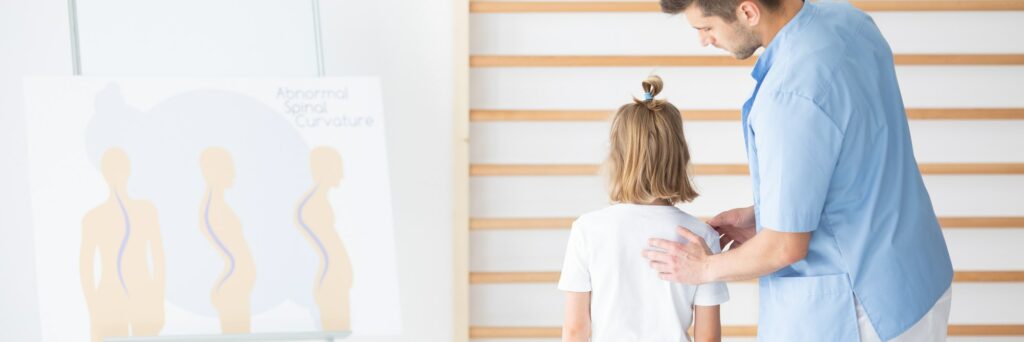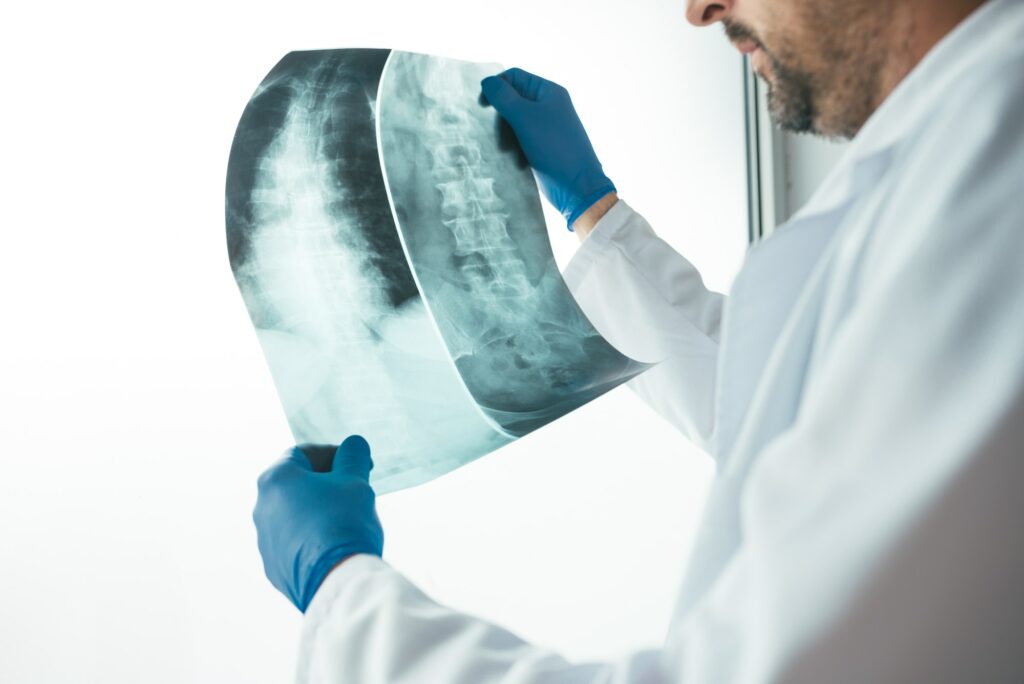Scheuermann’s disease is a spinal disorder that can cause back pain and kyphosis, in which the upper back is excessively curved.
It is essential to understand the causes, symptoms, and treatment options for this condition, especially for individuals who are experiencing discomfort in their backs.
Scheuermann’s disease is a spinal disorder that affects the thoracic vertebrae, causing vertebral wedging and leading to a rounded, hunchback appearance known as kyphosis. The condition typically develops during adolescence and affects males more often than females.
Scheuermann’s disease is characterised by abnormal growth of the thoracic vertebrae, resulting in wedge-shaped vertebrae and a loss of the spine’s normal curvature. The disease develops due to a combination of genetic and environmental factors, including abnormal cartilage development and endplate irregularities.
The thoracic spine is the middle portion of the spinal column, consisting of 12 vertebrae located between the cervical and lumbar spines. Vertebral wedging in Scheuermann’s disease is most commonly seen in the mid-thoracic region.
In addition to these classifications, Scheuermann’s disease can also be categorised based on the severity of kyphosis and associated conditions such as scoliosis.
Understanding the anatomy and pathogenesis is crucial for accurately diagnosing and treating the condition. In the next section, we will discuss the signs and symptoms associated with this spinal disorder.
Scheuermann’s disease is a spinal disorder that can cause a number of signs and symptoms. One of the most common complaints is back pain, which can range from mild discomfort to severe, debilitating pain. Pain may be felt in the upper or lower back, and can be exacerbated by physical activity or prolonged periods of sitting or standing.

Another common sign is kyphosis, a forward rounding of the thoracic spine. This can result in a noticeable hump in the upper back and lead to posture and movement difficulties. In addition to the physical manifestations, individuals with Scheuermann’s disease may experience emotional and psychological impacts, such as low self-esteem and depression.
It is important to note that not all individuals will experience the same signs and symptoms, and the severity of these symptoms can vary widely. If you are experiencing any of the above signs or symptoms, you must speak with your healthcare provider for an accurate diagnosis and appropriate treatment plan.
The exact cause of Scheuermann’s disease is not yet fully understood. However, studies suggest that genetic factors and abnormal growth of the vertebrae may play a role in its development.
Research indicates that the condition may be inherited, with certain genetic mutations increasing the risk of developing Scheuermann’s disease. Additionally, abnormal growth of the thoracic vertebrae and subsequent vertebral wedging are believed to contribute to the condition.

Other risk factors associated with Scheuermann’s disease include poor posture, lack of physical activity, and trauma to the spine. The condition is also more commonly diagnosed in males than females.
Research has identified several genes that may be associated with Scheuermann’s disease. Mutations in these genes can disrupt normal vertebral growth and development, leading to vertebral wedging and kyphosis.
However, it’s important to note that having a genetic predisposition to the condition doesn’t necessarily mean that it will develop. Environmental factors such as poor posture and physical activity levels may also contribute to its onset.
Two factors contribute to abnormal vertebral growth: growth plates and vertebral wedging. Growth plates are areas of developing bone tissue that produce new bone cells, leading to growth in vertebrae. In the case of Scheuermann’s disease, the growth of the thoracic vertebrae is disrupted, leading to abnormal wedging and kyphosis. Vertebral wedging is caused by an uneven growth pattern resulting in the vertebrae’s front growing more quickly than the back.
Although the exact cause is still unknown, understanding the potential contributing factors can aid in its diagnosis and management.
Diagnosing can be complex, as its signs and symptoms are similar to those of other spinal disorders. Healthcare professionals typically begin with a physical examination, assessing posture, flexibility, and range of motion. Medical history and family history are also important factors in determining the diagnosis.
The presence of kyphosis is a key indicator of Scheuermann’s disease. Healthcare professionals can often spot kyphosis during a visual examination. X-rays can confirm the presence of vertebral wedging and help determine the severity of the condition.
Other spinal disorders have similar symptoms to Scheuermann’s disease, such as a herniated disc or spinal stenosis. Healthcare professionals may perform further testing, such as an MRI or CT scan, to rule out other conditions and confirm the diagnosis of Scheuermann’s disease.

If a diagnosis of Scheuermann’s disease is confirmed, a healthcare professional may recommend postural correction techniques and physical therapy. In more severe cases, a brace may be necessary to help correct the curvature of the spine.
There are several treatment options available for managing Scheuermann’s disease. These options are usually tailored to meet the individual patient’s unique needs. In general, treatment aims to alleviate pain and improve spinal alignment.
If you are experiencing back pain or have been diagnosed with Scheuermann’s disease, it is important to speak to a healthcare professional to determine the best treatment options for you. With the right approach, individuals can effectively manage their symptoms and improve their quality of life.
Living with Scheuermann’s disease can be challenging, but it doesn’t have to hinder one’s quality of life. With the right treatment and management strategies, individuals with the condition can thrive daily. Here are some recommendations:

Regular exercise is crucial for managing Scheuermann’s disease. Strengthening the back muscles can help improve posture and alleviate pain. However, it’s important to consult with a healthcare professional to receive guidance on appropriate exercises and movements that won’t exacerbate the condition.
Dealing with chronic pain can be difficult, but several pain management strategies can help. These include medication, physical therapy, and acupuncture. Working with a healthcare provider is important to find the right approach for each individual’s needs.
Bracing may be necessary for individuals with severe kyphosis. A brace can help support the spine and prevent further curvature. A healthcare provider can recommend the appropriate brace and guide proper use.
Practising good posture is essential for individuals with Scheuermann’s disease. Sitting and standing up straight can help alleviate pain and improve breathing. Physical therapy can also help individuals learn proper posture techniques.
Living with chronic pain can take a toll on mental health. It’s important to seek support from loved ones and healthcare providers. Therapy and mindfulness techniques can also be beneficial for managing stress and anxiety.
Managing Scheuermann’s disease effectively requires a multi-faceted approach. By incorporating these strategies into daily life, individuals with the condition can achieve an improved quality of life.